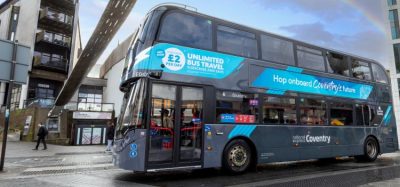Travel in London becoming more convenient with over 12 million contactless journeys made since launch
- Like
- Digg
- Del
- Tumblr
- VKontakte
- Buffer
- Love This
- Odnoklassniki
- Meneame
- Blogger
- Amazon
- Yahoo Mail
- Gmail
- AOL
- Newsvine
- HackerNews
- Evernote
- MySpace
- Mail.ru
- Viadeo
- Line
- Comments
- Yummly
- SMS
- Viber
- Telegram
- Subscribe
- Skype
- Facebook Messenger
- Kakao
- LiveJournal
- Yammer
- Edgar
- Fintel
- Mix
- Instapaper
- Copy Link
Posted: 13 November 2014 | Transport for London
More than 12 million public transport journeys have now been made using contactless payment cards and devices since Transport for London (TfL) launched the new more convenient way to pay on 16 September…


More than 12 million public transport journeys have now been made using contactless payment cards and devices since Transport for London (TfL) launched the new more convenient way to pay on 16 September.
Contactless payments, part of TfL’s work to modernise and improve the service offered to customers, can be made for travel on the Tube, London Buses, tram, DLR, London Overground and most National Rail services in London.
The new payment method has been available on the bus network since December 2012 and since it launched across transport in London there has been a significant rise in bus journeys using contactless payments, with the highest being 154,000 journeys in a day. The total number of journeys on Tube and rail services in London has now reached over 5.5 million and the total number of journeys on London Buses and trams since contactless payments launched across transport in London is now over 6.5 million. Friday 7 November saw the busiest day on rail for journeys using contactless payments, with 164,000 made.
Contactless payments are now making up nearly 8 per cent of all pay as you go journeys on the network, with the most popular London Underground stations for contactless being Oxford Circus, Kings Cross and London Bridge.
Using contactless payments for travel is easy. Customers with a UK issued contactless payment card (debit, credit, charge or pre-paid cards) just simply have to touch their card on the reader. There is no need to sign up for an online account with TfL, but there are many benefits if customers choose to, including being able to see 12 months of journey and payment history. Customers who don’t have an online account can still access their journey and payment history, but only for the last seven days. Contactless payments work in the same way as Oyster, charging customers an adult-rate pay as you go fare when they touch in and out on readers at the start and end of every journey.
Customers using contactless payments for their travel can benefit from having their fares capped – this automatically calculates the best fare for their contactless travel in a day or over a seven-day period from Monday to Sunday. Oyster continues to be available, with contactless payments being another option that lets customers travel without the need to top up Oyster credit.
Shashi Verma, TfL’s Director of Customer Experience, said: “It is fantastic to see over 12 million contactless journeys across London within just two months. Using contactless payments to travel can save customers time and money; they don’t need to stop to top-up an Oyster card, or buy a ticket and can benefit from daily and Monday to Sunday capping.”
Craig Jones, spokesperson for The UK Cards Association, said: “It’s great news that so many Londoners have chosen to use their contactless cards for daily travel, with the number of contactless journeys by the Tube and bus showing the extent to which the technology has been warmly received. Analysis from our members shows that the launch of contactless payments on TfL services has inspired many consumers to use their cards for the first time. We hope that once new users experience the speed, ease and convenience of this payment method on the transport system, they will go on to use their contactless cards in a range of other settings, including shops, cafes and restaurants.”
Under the new fares for 2015, announced by The Mayor earlier this week, customers using contactless or Oyster on pay as you go will benefit from the all-day cap for Zones 1-2 being cut by £2.00 from £8.40 to £6.40; and for Zones 1-6 by over £4.00 from £15.80 to £11.70.
The potential savings will be considerable, ranging from £200 to over £600 per year. When a 3 days a week customer travels between Zones 1-5 in 2015 they will pay a maximum of £10.90 a day, rather than the current maximum of £15.80, saving £4.90 a day, or £14.70 a week. Over a year (for example, 45 weeks) the savings could be up to £600.
Card clash is being closely monitored and customers are being refunded when they may have accidentally touched more than one card on a reader and paid with a card they did not intend to use. On average there have been 1,564 instances each weekday where customers may have accidentally paid with a contactless payment card they did not intend to pay with and all of these are being automatically refunded by TfL. This figure compares with a pre-launch estimate of around 2,000 – less than 0.1 per cent of the smartcard rail journeys made in London every day.
Related topics
Fleet Management & Maintenance, Ticketing & Payments
Related cities
London, United Kingdom
Related organisations
Transport for London (TfL)








